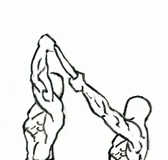Last Updated on November 8, 2023
How doing Pilates helps you stay fit through pregnancy and makes it easier for the body to recover after childbirth. By Ivy Ong.
Should pregnant women exercise? The simple answer is yes because a healthy and active lifestyle with a regular exercise regimen benefits everybody. For pregnant women, exercising can decrease pregnancy symptoms like backaches, bloating, fatigue, swollen ankles, even gestational diabetes according to research, and other discomforts when you’re expecting. What’s more, exercising through pregnancy helps the body become more resilient, making recovery after childbirth – also known as postpartum recovery – quicker and easier.
If you’ve led a physically active lifestyle before pregnancy, you should be able to carry on with your activities in moderation and with modification. High-impact cardio should definitely not be on your list of activities while pregnant, but swimming, walking, yoga, and Pilates are highly recommended prenatal exercises. Don’t worry if you’ve never exercised regularly before, pregnant women can safely begin an exercise program following the advice of their doctor.
For your safety and to make the most of your workout, consult with a trainer knowledgeable in prenatal and postnatal exercises. In pilates, instructors specialize in pre-natal or postnatal pilates and can customize an appropriate exercise program during pregnancy and postpartum.
Pre-natal Pilates
Pregnant women are more prone to backaches and pain around the pelvic area, which is partly due to changes in posture as the baby grows, partly due to the weight of the baby, and partly due to hormones. Doing pilates strengthens abdominal muscles as well as deep stabilizer muscles, this, in turn, strengthens the whole torso so that aches and pains are minimized.
As your posture changes with the growing baby, you may feel clumsier and less balanced. Pre-natal Pilates not only trains pregnant women to be more sensitive to weight distribution but also teaches correct weight distribution with good posture and alignment. The exercises in pre-natal pilates are done in a way to help reduce the load on the pelvis and lower back, and through these exercises, you will learn to find safe and comfortable positions for yourself as you move about in daily life throughout your pregnancy.
Postnatal Pilates
The foundation of Pilates is all about breathing, moving with the breath, and moving with intention, so you can actually start doing Pilates days after childbirth. Ask your Pilates instructor to guide you through breathing exercises plus pelvic floor and abdominal muscle activation exercises. If your instructor can create a program for you to work on in your own time at home, do these regularly to promote mobility and circulation as well as to regain strength.
Doctors would advise waiting six to seven weeks to begin exercising again, and as with other exercises, you can safely start doing postnatal pilates in the sixth to seventh week of postpartum recovery. Postnatal pilates brings back good posture and alignment while strengthening mothers for the physical demands, and even emotional demands, of caring for the baby. It also helps you regain muscular strength in key areas that were affected by pregnancy and delivery.
Ask All Core Pilates about prenatal and postnatal Pilates. Located at the Upper Ground Floor, Alabang Town Center. Call or text 0917-187-2207 for more information.






